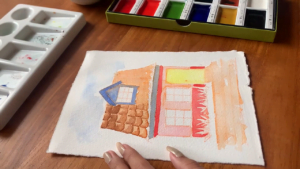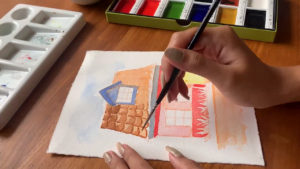Gouache Paint: bold colors, subtle blending, and endless possibilities for creativity. This versatile medium offers a unique set of properties that make it stand out from the crowd, providing artists with the perfect way to inject new life into their art.

What if there was a way to inject some excitement and unpredictability into your artwork? That's exactly what Gouache Paints do. With its lively colors, subtle blending techniques, and versatile application, Gouache Paint is like a shot of adrenaline for your art.
So, if you're ready to break out of your creative comfort zone and try something new, let's take a closer look at the fascinating world of Gouache Paint.
Gouache: The Secret Weapon of Artists Everywhere

"Gouache? What is that?" Well, gouache paint is a unique medium that combines the best of both watercolor and acrylic paint. It's like the lovechild of these two popular mediums, offering the best of both worlds. Intrigued yet? Let's dive in and learn more!
Gouache paint is a special watercolor paint that has been used by artists for centuries. The word "gouache" comes from the Italian word "guazzo," which means "mud" or "watercolor painting."
It has a unique characteristic that sets it apart from other mediums: it's opaque! That's right, folks - no more dealing with transparent washes or layering for hours on end. With gouache, you get that beautiful, solid coverage in just one swipe.
Now, let's talk about how gouache compares to other mediums. First of all, it's often compared to watercolor due to the fact that they both use water as a solvent. However, while watercolor is a transparent medium, gouache is opaque, which makes it perfect for creating chalk-like pastel effects.
This means that you can layer lighter colors over darker colors without the watercolors getting muddied or washed out. Additionally, gouache has a matte finish, which is perfect for achieving a more velvety look in your paintings.
When compared to oil painting, gouache has the advantage of being less toxic and easier to clean up. In order to clean oil paints, solvents such as turpentine are necessary, but they can be harmful to breathe in and require proper disposal. Gouache, on the other hand, can be cleaned up with just water.
The Magic of Gouache
So, what are the properties of gouache paint? Aside from its opaque and matte characteristics, gouache is also known for its ability to dry quickly. This makes it great for artists who want to work on their pieces in shorter sessions. Another advantage of gouache is its versatility. It can be thinned down with water to create washes or thickened up for impasto effects. The possibilities are truly endless!
But wait, there's more! Gouache is a true champion when it comes to mixing colors. With just a bit of water, you can make lighter shades or mix them with other colors to produce new ones. This means you have the power to create endless shades and hues to bring your artistic vision to life. Plus, layering colors with gouache is a breeze, allowing you to add depth and dimension to your paintings.
Gouache paint adheres like glue to a variety of surfaces, including paper, canvas, and board. And don't even get me started on pigment density. Gouache has a high pigment density, which means that a little bit of paint goes a long way.
Finally, we have water resistance. Once gouache paint has dried, it becomes water-resistant, which means you can paint over it with watercolors or other water-based mediums without worrying about the gouache bleeding or smudging. This gives you even more creative freedom to try out different techniques and mediums.
Overall, gouache paint is a unique and versatile medium that any artist should have in their arsenal. Its opaque and matte characteristics set it apart from others, and its quick-drying and versatile properties make it perfect for a wide range of projects.

How to Use Gouache Paint?
Let's explore how to use this highly pigmented and opaque watercolor paint and unleash your inner artist with these exciting techniques!
Materials Needed for Gouache Painting
To start with gouache painting, you will need a few essential supplies. First and foremost, you will need gouache paints. You can use natural or synthetic pigments, depending on your preference. Next, you will need watercolor brushes and watercolor paper, and a mixing palette.
You may also need a spray bottle to mist the paper or the paint to achieve specific textures or effects. Additionally, drafting tape or masking tape can come in handy to create clean edges and borders on your paintings. A ruler can be useful for measuring and drawing straight lines.
Other optional materials you may need include a pencil for sketching your design, a kneaded eraser, and a palette knife for mixing paint.
Finally, it's worth investing in a good-quality easel to hold your paper while you paint. This will allow you to work comfortably and avoid any unwanted smudging or smearing of your work.
Overall, while gouache painting does not require a vast array of materials, having the right tools and equipment can significantly improve the quality of your artwork and enhance your overall painting experience.
Techniques for Gouache Painting
From basic application techniques to advanced methods, there are plenty of techniques you can use to make your paintings come alive.
1. Basic Application Techniques
The basic application techniques are the foundation of any great gouache painting. These are the techniques that every artist must master before moving on to more advanced methods. Let's take a closer look at how you can use them to create stunning works of art.
A. Brush Techniques
With a flick of the wrist and a dab of gouache paint, it is possible to create a world of texture and depth on your canvas. Whether you prefer small and detailed brushes or large and loose strokes, the possibilities are endless.
B. Layering Techniques
Ah, the joy of layering! As you add layer upon layer of gouache paint, your painting will come alive with vibrant color and depth. It's like building a sandcastle, only with paint!
C. Wet-on-Wet and Wet-on-Dry Techniques
These techniques are all about controlling the flow of your gouache paint. Whether you want to create soft, blended washes or sharp, crisp edges, you can achieve it all with these versatile techniques.
2. Advanced Techniques
Once you've mastered the basics, it's time to take your gouache painting to the next level with these advanced techniques.
A. Impasto Effects
With thick, buttery strokes of gouache paint, it is possible to create a three-dimensional effect that practically jumps off the canvas. It's like sculpting with paint!
B. Scumbling and Glazing Techniques
These techniques are all about playing with light and shadow, creating a sense of depth and luminosity that will make your paintings glow.
C. Mixed Media Techniques
Who says gouache paint has to be used on its own? By combining it with other materials like acrylic paint, acrylic gouache, or even acrylic inks, a whole new world of texture and color can be created.
And don't forget - there are always more techniques to discover and explore, from dry brushing to adding fine details. The possibilities are truly endless with gouache paint!
Tips for Working with Gouache Paint
Here are some tips and tricks for working with gouache paint that is sure to take your artwork to the next level:
1. Embrace the Opacity
Unlike watercolor, gouache paints are known for their opacity, which makes them perfect for creating flat and solid areas of color. Use this quality to your advantage and try out different techniques to create unique and eye-catching effects.
2. Mix it Up
One of the joys of working with gouache paints is their ability to be mixed with other colors to create new shades. Be sure to have the primary colors on hand to create any hue you desire. Don't be afraid to mix in a little white gouache to tone down the intensity of a color or to add highlights.
3. Choose the Right Surface
Gouache paint works well on a variety of surfaces, but it's best to use it on surfaces that are absorbent and have a matte finish, such as watercolor paper or illustration board. Avoid using it on glossy or slick surfaces as it may not adhere properly.
4. Experiment with Dry Brushing
Dry brushing is a technique that involves taking a small amount of paint and applying it to a dry brush and dragging it across the surface of the paper. This technique can create a textured, almost scratchy effect, which is perfect for adding interest to backgrounds or creating the illusion of fur or feathers.
5. Add Gum Arabic
If you want to create a more fluid consistency with your gouache paint, try adding gum Arabic to the mix. This binding agent helps to make the paint more water-soluble and can also help to create a more matte surface.
6. Consider Acrylic Gouache
If you're familiar with working with acrylic paints, you might want to try out acrylic gouache, which has the same opaque qualities as traditional gouache but is water-resistant when dry. This makes it a great option for creating outdoor murals or paintings that may be exposed to moisture.
7. Protect your Work
Gouache paintings can be fragile and susceptible to damage if not properly protected. Once your painting is complete, be sure to store it in a protective sleeve or frame it behind glass to prevent it from getting smudged, scratched, or exposed to moisture. This will help ensure that your artwork lasts for years to come.
Examples of Gouache Paint in Art
Gouache paint has been used by artists for centuries to create stunning works of art. From the iconic landscapes of France's en plein air movement to modern-day commercial designs, gouache paint has found its place in the art world as a versatile and unique medium.
Famous artists like Henri Matisse have used gouache to create bold and bright works of art. Contemporary artists continue to push the boundaries of what is possible with gouache, exploring new techniques and textures that add depth and dimension to their work.
Applications for gouache paint are endless, with artists using it in fine art painting, graphic design, and illustration. Gouache is perfect for creating flat and solid areas of color, making it an ideal choice for poster and logo design, children's book illustrations, and even comic book art.

Parting Thoughts
Gouache Paint is like that friend who always manages to surprise you with their incredible talents and versatility.
It's not just paint; it's a personality, a mood, a vibe. If you're an artist or someone who loves to dabble in art, Gouache Paint can add a touch of magic to your artwork, making it pop and come to life in ways you never thought possible.
With its lively and vibrant colors, subtle blending techniques, and versatile application, Gouache Paint is the perfect medium to bring your art to life.
So, to all my fellow creatives out there, don't be afraid to try something new and exciting. Let your imagination run wild, and let Gouache Paint be the canvas for your wildest dreams and ideas.
